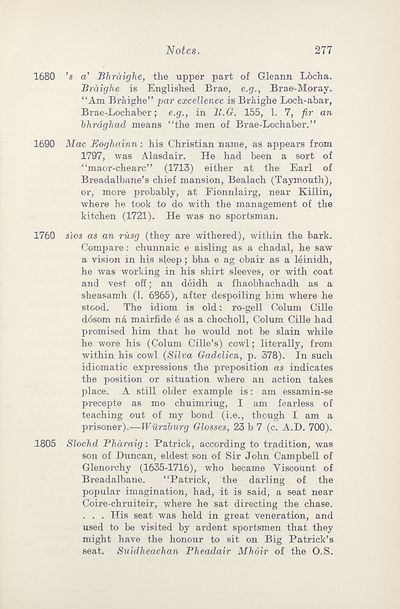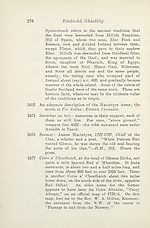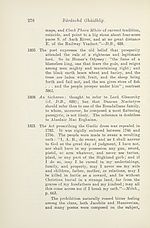Download files
Complete book:
Individual page:
Thumbnail gallery: Grid view | List view

Notes.
277
1680 ’s a’ Bhraighe, the upper part of Gleann Locha.
Braighe is Englished Brae, e.g., Brae-Moray.
“Am Braighe” par excellence is Braighe Loch-abar,
Brae-Lochaber; e.g., in li.G. 155, 1. 7, fir an
bhrdghad means “the men of Brae-Lochaber.”
1690 Mac Eoghainn: his Christian name, as appears from
1797, was Alasdair. He had been a sort of
“maor-chearc” (1713) either at the Earl of
Breadalbane’s chief mansion, Bealach (Taymouth),
or, more probably, at Fionnlairg, near Killin,
where he took to do with the management of the
kitchen (1721). He was no sportsman.
1760 slos as an rusg (they are withered), within the bark.
Compare: chunnaic e aisling as a chadal, he saw
a vision in his sleep; bha e ag obair as a leinidh,
he was working in his shirt sleeves, or with coat
and vest off; an deidh a fhaobhachadh as a
sheasamh (1. 6865), after despoiling him where he
stood. The idiom is old: ro-gell Colum Cille
dosom na mairfide 6 as a ehocholl, Colum Cille had
promised him that he would not be slain while
he wore his (Colum Cille’s) cowl; literally, from
within his cowl (Silva Gadelica, p. 378). In such
idiomatic expressions the preposition as indicates
the position or situation where an action takes
place. A still older example is: am essamin-se
precepte as mo chuimriug, I am fearless of
teaching out of my bond (i.e., though I am a
prisoner).—Wurzburg Glosses, 23 b 7 (c. A.D. 700).
1805 Slochd Phdraig: Patrick, according to tradition, was
son of Duncan, eldest son of Sir John Campbell of
Glenorchy (1635-1716), who became Viscount of
Breadalbane. “Patrick, the darling of the
popular imagination, had, it is said, a seat near
Coire-chruiteir, where he sat directing the chase.
. . . His seat was held in great veneration, and
used to be visited by ardent sportsmen that they
might have the honour to sit on Big Patrick’s
seat. Suidheachan Pheadair Mhoir of the O.S.
277
1680 ’s a’ Bhraighe, the upper part of Gleann Locha.
Braighe is Englished Brae, e.g., Brae-Moray.
“Am Braighe” par excellence is Braighe Loch-abar,
Brae-Lochaber; e.g., in li.G. 155, 1. 7, fir an
bhrdghad means “the men of Brae-Lochaber.”
1690 Mac Eoghainn: his Christian name, as appears from
1797, was Alasdair. He had been a sort of
“maor-chearc” (1713) either at the Earl of
Breadalbane’s chief mansion, Bealach (Taymouth),
or, more probably, at Fionnlairg, near Killin,
where he took to do with the management of the
kitchen (1721). He was no sportsman.
1760 slos as an rusg (they are withered), within the bark.
Compare: chunnaic e aisling as a chadal, he saw
a vision in his sleep; bha e ag obair as a leinidh,
he was working in his shirt sleeves, or with coat
and vest off; an deidh a fhaobhachadh as a
sheasamh (1. 6865), after despoiling him where he
stood. The idiom is old: ro-gell Colum Cille
dosom na mairfide 6 as a ehocholl, Colum Cille had
promised him that he would not be slain while
he wore his (Colum Cille’s) cowl; literally, from
within his cowl (Silva Gadelica, p. 378). In such
idiomatic expressions the preposition as indicates
the position or situation where an action takes
place. A still older example is: am essamin-se
precepte as mo chuimriug, I am fearless of
teaching out of my bond (i.e., though I am a
prisoner).—Wurzburg Glosses, 23 b 7 (c. A.D. 700).
1805 Slochd Phdraig: Patrick, according to tradition, was
son of Duncan, eldest son of Sir John Campbell of
Glenorchy (1635-1716), who became Viscount of
Breadalbane. “Patrick, the darling of the
popular imagination, had, it is said, a seat near
Coire-chruiteir, where he sat directing the chase.
. . . His seat was held in great veneration, and
used to be visited by ardent sportsmen that they
might have the honour to sit on Big Patrick’s
seat. Suidheachan Pheadair Mhoir of the O.S.
Set display mode to:
![]() Universal Viewer |
Universal Viewer | ![]() Mirador |
Large image | Transcription
Mirador |
Large image | Transcription
| An Comunn Gàidhealach > An Comunn Gàidhealach Publications > Bardachd Ghaidhlig > (345) |
|---|
| Permanent URL | https://digital.nls.uk/126285272 |
|---|
| Description | This contains items published by An Comunn, which are not specifically Mòd-related. It includes journals, annual reports and corporate documents, policy statements, educational resources and published plays and literature. It is arranged alphabetically by title. |
|---|
| Description | A collection of over 400 items published by An Comunn Gàidhealach, the organisation which promotes Gaelic language and culture and organises the Royal National Mòd. Dating from 1891 up to the present day, the collection includes journals and newspapers, annual reports, educational materials, national Mòd programmes, published Mòd literature and music. |
|---|---|
| Additional NLS resources: |
|

